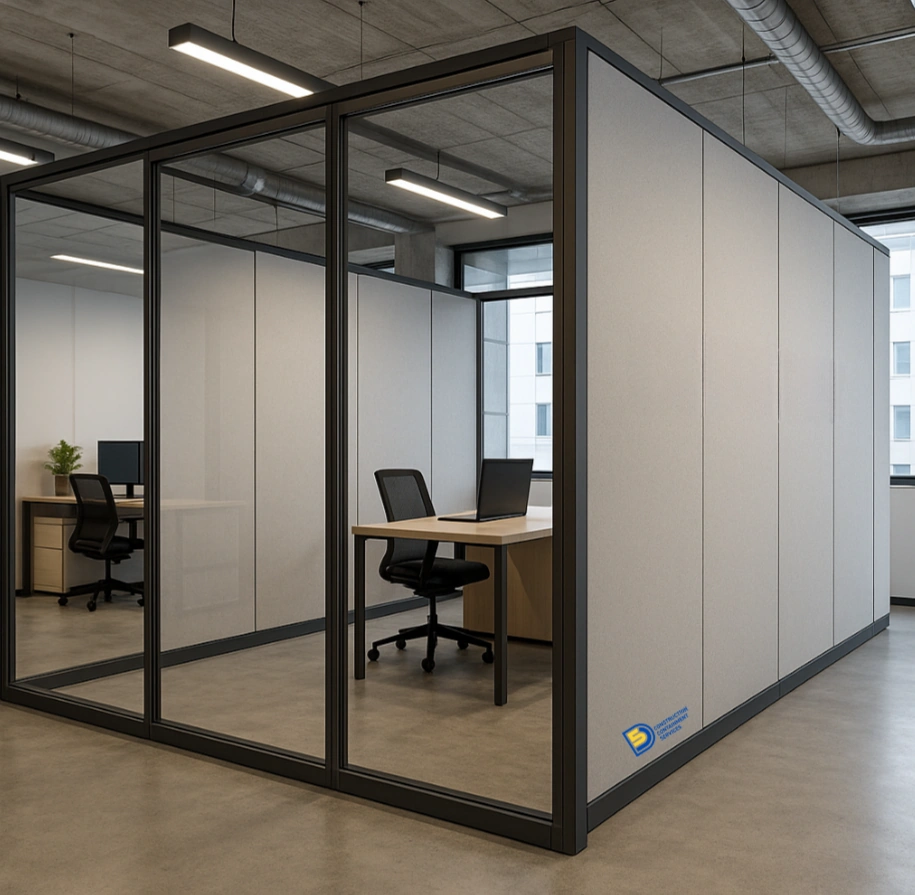Modular Temporary Wall Pricing in California: Complete Cost Guide and Options
Modular Temporary Walls for Office Spaces Californiaare rapidly transforming how commercial environments function and evolve. Across California’s major dynamic business hubs in San Francisco, Los Angeles, San Jose, and beyond, companies are adopting modular wall systems to meet demands for agility, privacy, and sustainability. Whether launching a new startup floorplan or reconfiguring an existing layout, modular walls offer quick installation, noise control, and a dust-free alternative to permanent construction.
What makes these solutions particularly valuable in California is their flexibility in meeting changing building codes, local permitting needs, and workspace regulations—without sacrificing design or durability. As companies seek smarter space management and cost-effective renovation alternatives, prefabricated and demountable wall systems are becoming a cornerstone of modern office infrastructure.
In this post, we’ll explore how modular temporary walls are shaping today’s office environments, from quick-ship installationsto turn-key rental optionsthat minimize disruption while maximizing impact. For more on the environmental and design benefits, explore our Sustainable Modular Temporary Walls in Californiasolutions.
Why California Offices Are Embracing Modular Temporary Walls
In a state defined by innovation, space scarcity, and evolving building codes, California offices are turning to modular temporary wallsas a practical, forward-thinking solution. These systems offer unmatched adaptability in a market where workspace needs can shift rapidlydue to tech growth, hybrid work models, and regional real estate dynamics.
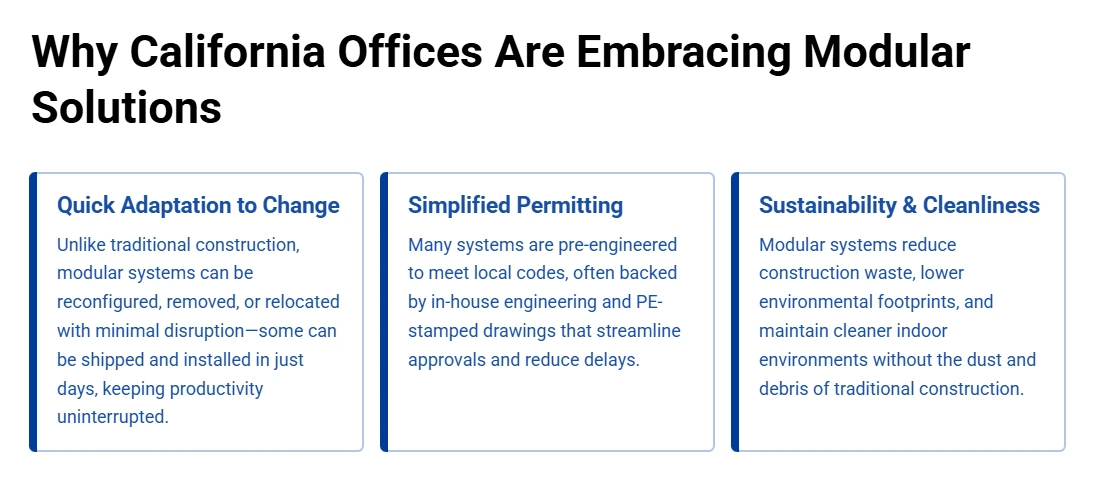
Quick Adaptation to Change
Unlike traditional construction, modular wall systems can be reconfigured, removed, or relocatedwith minimal disruption. Startups and enterprise-level companies alike are finding value in the speed of installation—some modular systems can be shipped and installed in just a few days, keeping timelines tight and productivity uninterrupted.
Permitting Made Simple
California’s complex permitting process can be a barrier to office renovations. However, many modular systems—especially those offered by experienced providers—are pre-engineered to meet local codes, often backed by in-house engineering and PE‑stamped drawings that streamline approvals and reduce delays.
Design Meets Compliance
Modular systems today are not just functional; they’re visually appealing too. Many solutions include glass panels, integrated doors, soundproofing, and fire-rated materials—balancing aesthetics with code compliance, privacy, and workplace comfort.
Sustainability & Cleanliness
California businesses are increasingly seeking eco-conscious, low-disruption solutions. Modular systems provide a powerful opportunity to reduce construction waste and lower environmental footprints—benefits well documented in modular construction research. For example, the Modular Building Institute notes significant reductions in waste, carbon emissions, and embodied energy, as well as the potential for building reuse and enhanced energy efficiency. Explore our Sustainable Modular Temporary Walls in Californiafor insights on how modular containment helps reduce waste and maintain cleaner indoor environments.
Smart Planning for Disruption-Free Renovation
Containment is key to managing modern renovation projects smoothly. That’s why we also recommend the guide on How to Plan for Temporary Containment During Renovation, which is packed with practical tips on scoping, layout considerations, and ICRA compliance for various work environments.
Scalable for Growth
With rapid hiring or downsizing more common than ever, businesses need offices that can flex. Modular walls allow teams to add private offices, remove conference spaces, or build collaborative hubs—all without the mess of traditional renovation.
Quick‑Ship & Turn‑Key Solutions: Speed Meets Flexibility
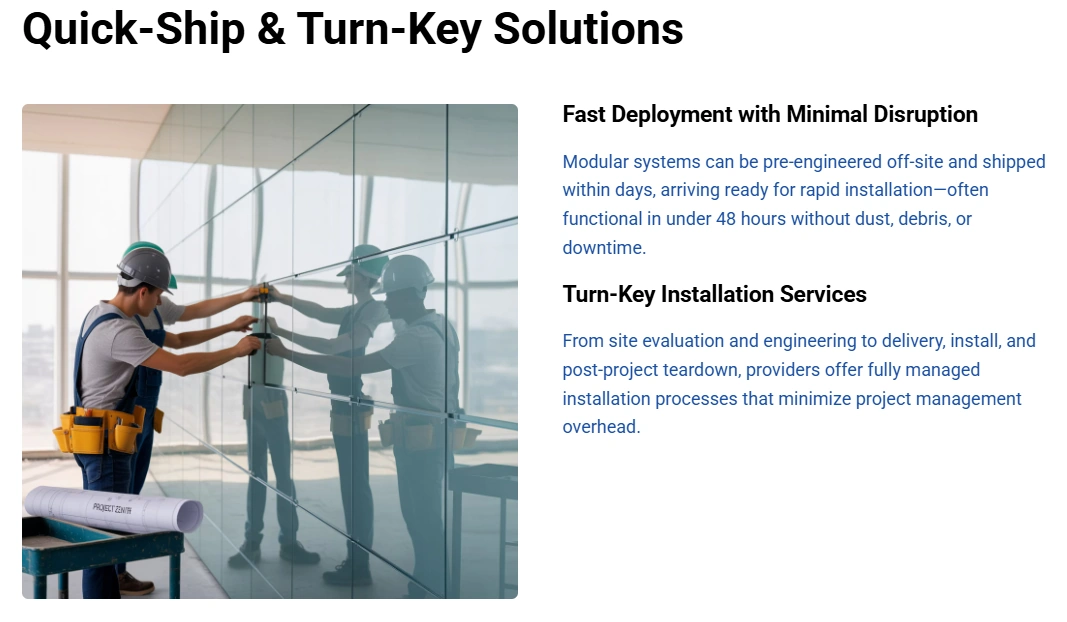
For California offices looking to reconfigure space with minimal downtime, modular temporary walls offer a clear advantage. Whether you’re retrofitting an existing floor plan or scaling up to meet new demand, quick‑ship and turn‑key modular solutionsmake it possible to move from planning to execution in a matter of days—not weeks.
Fast Deployment with Minimal Disruption
Traditional renovations are disruptive, messy, and time-consuming. In contrast, modular systems can be pre-engineered off-site and shipped within a few days, arriving ready for rapid installation. In many cases, entire office partitions or containment zones are up and functional in under 48 hours, without the dust, debris, or downtime associated with drywall.
Turn‑Key Installation Services
One of the most appealing features for busy facility managers and project teams is the fully managed installation process. From site evaluation and engineering to delivery, install, and post-project teardown (if temporary), providers like 5DCCS offer true turn‑key services. This minimizes project management overhead and ensures timelines stay tight—ideal for tenant improvements, IT infrastructure upgrades, or urgent compliance projects.
Cleaner & Safer Job Sites
With no sawing, sanding, or traditional construction required on-site, modular wall installations keep your workspace cleaner, safer, and more predictable. For active office environments, healthcare facilities, or data centers, this dust-free and low-noise processcan be critical to maintaining business continuity.
Flexibility for Temporary or Permanent Use
Quick‑ship modular walls are not just for short-term fixes—they can be reconfigured, relocated, or left in place as long-term infrastructure. This gives you the flexibility to adapt without the sunk cost of permanent construction or the time waste of repeated demo work.
Design Options: Prefab, Demountable & Custom Panels
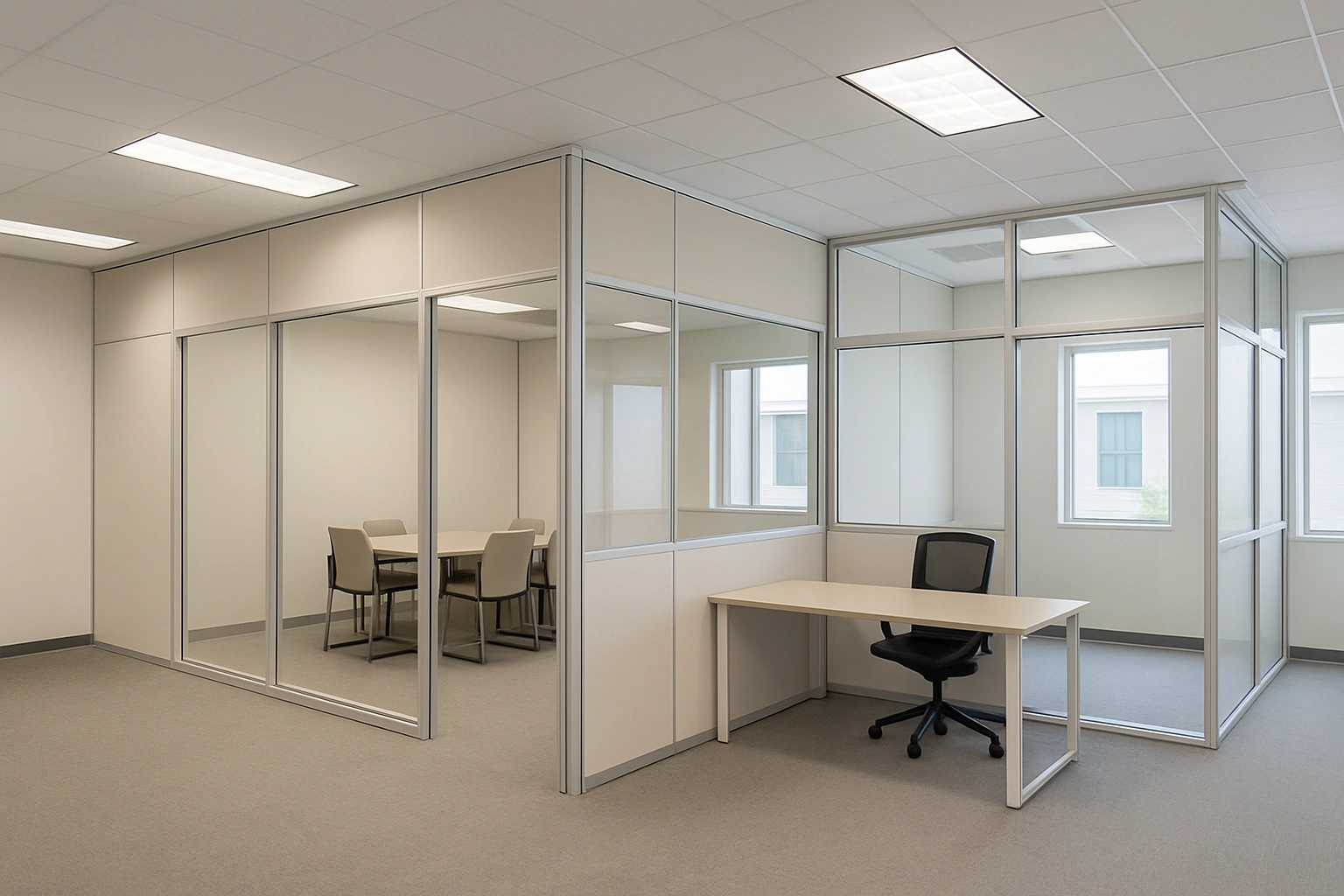
One of the key advantages of modular temporary walls in California office spaces is their customizability and flexibility in design. These aren’t generic partitions—they’re engineered systems tailored to suit your workflow, privacy needs, and branding preferences.
Prefab Wall Systems for Speed and Consistency
Prefabricated walls are manufactured off-site in controlled environments, ensuring precision quality and faster turnaround. These units often arrive fully finished with integrated components like electrical conduits, data ports, and HVAC chases—eliminating the guesswork and delays of on-site buildouts. Sources like The Access Grouphighlight how modular systems deliver customizable, high-quality results efficiently.
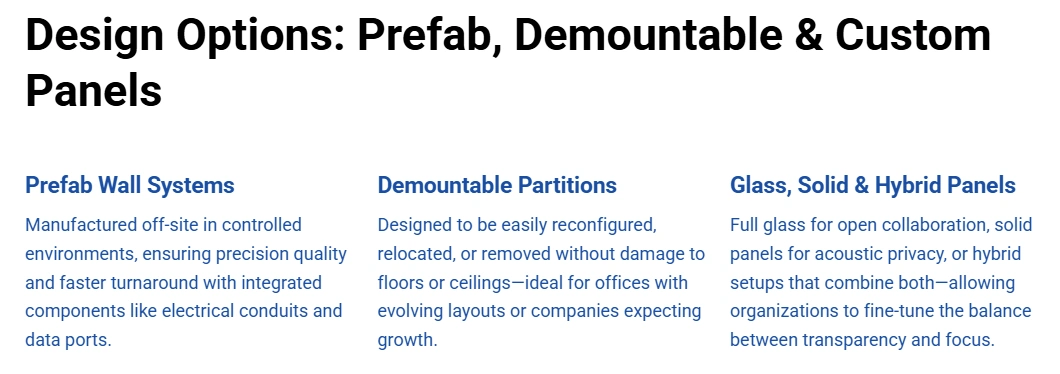
Demountable Partitions for Flexibility
Demountable walls are designed to be easily reconfigured, relocated, or removedwithout damage to floors or ceilings. This makes them ideal for offices with evolving layouts or companies expecting growth, contraction, or team reshuffling. Many systems use panelized tracksor floor-to-ceiling pressure-fit configurationsthat eliminate permanent fasteners altogether.
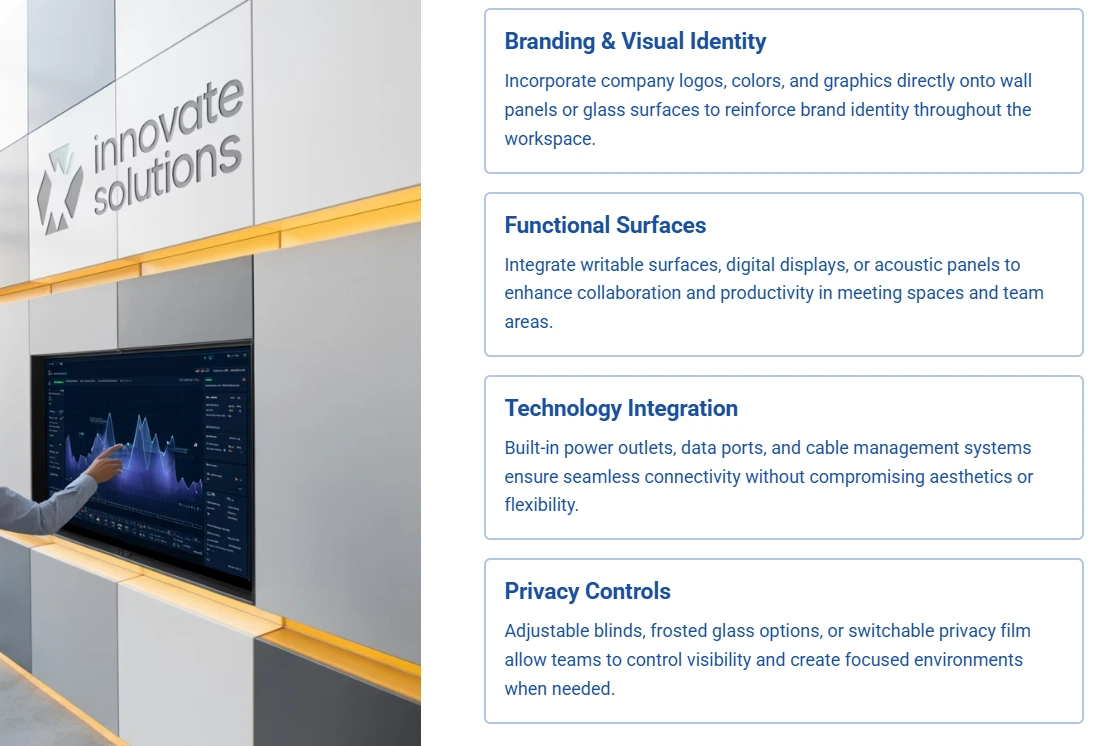
Glass, Solid, and Hybrid Panel Options
Today’s modular walls come in a range of styles—full glass for open collaboration, solid panels for acoustic privacy, or hybrid setupsthat combine both. This allows organizations to fine-tune the balance between transparency and focus based on each department’s needs.
Integrated Features for Modern Workspaces
You can customize modular walls with branding, writable surfaces, built-in storage, LED lighting strips, and Class A fire-rated materials. Soundproofing optionsare especially valuable in shared spaces, while modular door systems ensure ADA compliance and secure access.
Tailored for California’s Code & Climate
Because California has stringent seismic, accessibility, and energy regulations, leading modular systems are engineered with these requirements in mind. Working with local partners ensures that your walls meet state-specific standards, whether it’s CALGreen energy benchmarks or Title 24 lighting compliance.
Containment & Noise Control for Commercial Environments
As open-plan offices and mixed-use commercial spaces continue to dominate California’s urban landscape, containment and sound managementhave become key considerations for employers, architects, and facility managers. Modular temporary walls provide an effective, scalable solution—serving as physical and acoustic barriers that are both attractive and adaptable.
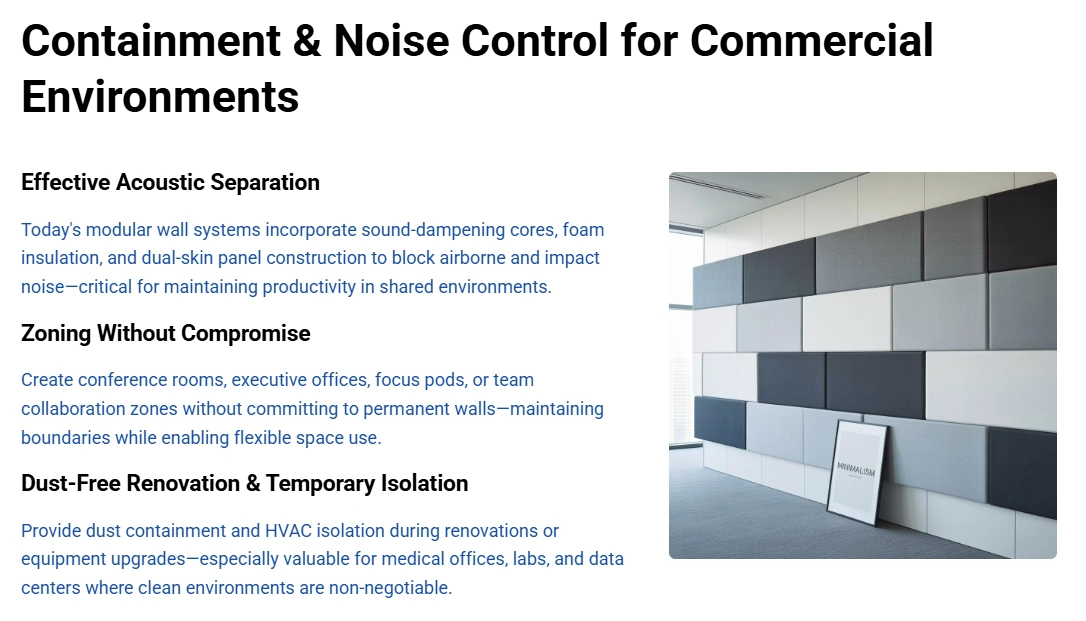
Effective Acoustic Separation
Today’s modular wall systems incorporate sound-dampening cores, foam insulation, and even dual-skin panel constructionto block airborne and impact noise. In shared environments like tech hubs or coworking spaces, this is critical for maintaining productivity and focus.
Zoning Without Compromise
Modular walls allow businesses to zone off specific work areas—such as conference rooms, executive offices, focus pods, or team collaboration zones—without committing to permanent walls. This means more flexible space use, while still maintaining boundaries and workflow clarity.
Dust-Free Renovation & Temporary Isolation
During renovations or equipment upgrades, modular walls can be installed to provide dust containment and HVAC isolation. They are especially useful for medical offices, labs, and data centers where clean environments are non-negotiable. Their non-porous surfaces are also easy to sanitize, supporting hygiene in high-traffic commercial areas.
Compliance-Ready Design
Containment isn’t just about productivity—it’s also about safety and regulatory compliance. Modular walls can be configured to meet ICRA (Infection Control Risk Assessment)standards, fire ratings, and even smoke control requirements, depending on use case and occupancy type.
Durability Meets Mobility
Though temporary by design, these walls are anything but flimsy. Many systems feature galvanized steel backing, aluminum framing, or urethane cores, making them strong enough to handle daily wear while still being light enough to reconfigure.
For a look at how these versatile containment capabilities apply across various sectors, check out Industries Benefiting from Temporary Wall Solutions.
Rentals vs Purchases: Scalable, Sustainable Choices
When investing in modular temporary walls, California businesses often face a key decision: rent or buy?The right answer depends on your project scope, timeline, and long-term space planning goals. Fortunately, both options support sustainability and scalability—hallmarks of modular wall systems.
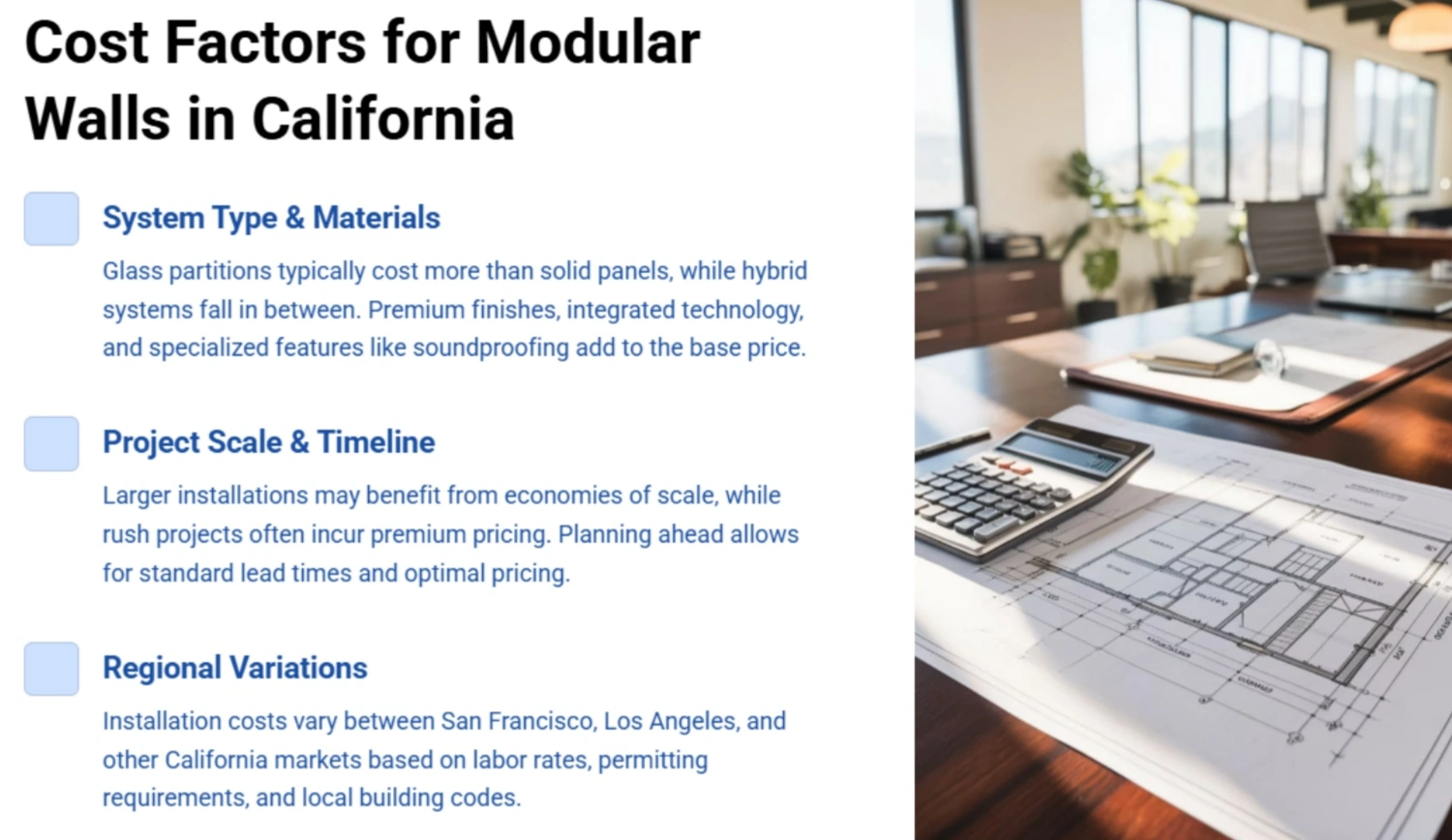
When to Rent Modular Walls
Short-term needs—like renovations, tenant improvements, or compliance-driven upgrades—are ideal use cases for rentals. Renting allows you to access turn-key containment or partitioning solutions without capital expenditure, making it budget-friendly and fast to deploy. Most rental packages include installation, teardown, and transportation, reducing operational burden for facilities teams.
When to Purchase Modular Systems
Buying is the better route when modular walls become part of your permanent layout strategy. Whether building out new departments or planning a hybrid work model, ownership offers long-term cost savingsand allows for greater customization. Purchased systems can be reconfigured indefinitely, supporting evolving spatial requirements and layout optimization over time.
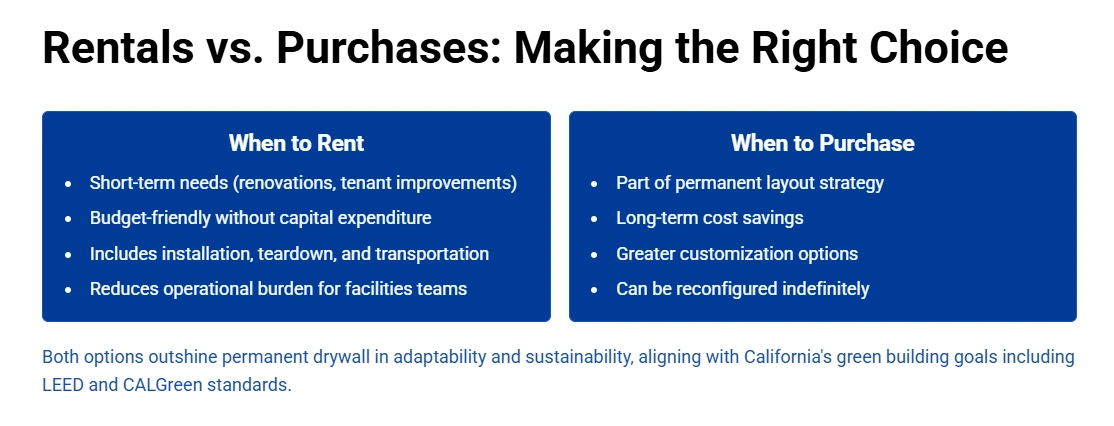
Flexibility Over Fixed Construction
Both rental and purchase options outshine permanent drywall in terms of adaptability. While traditional builds lock your floorplan in place, modular systems—rented or owned—can be moved, reused, or removed without waste or demolition. This aligns perfectly with California’s green building goals and sustainability benchmarks, including LEEDand CALGreen.
Sustainability Through Reuse
One of the greatest environmental advantages of modular walls is their reuse potential. Unlike drywall, which often ends up in landfills, modular panels can be repurposed project after project. This significantly reduces material waste, aligns with ESG goals, and supports circular design models.
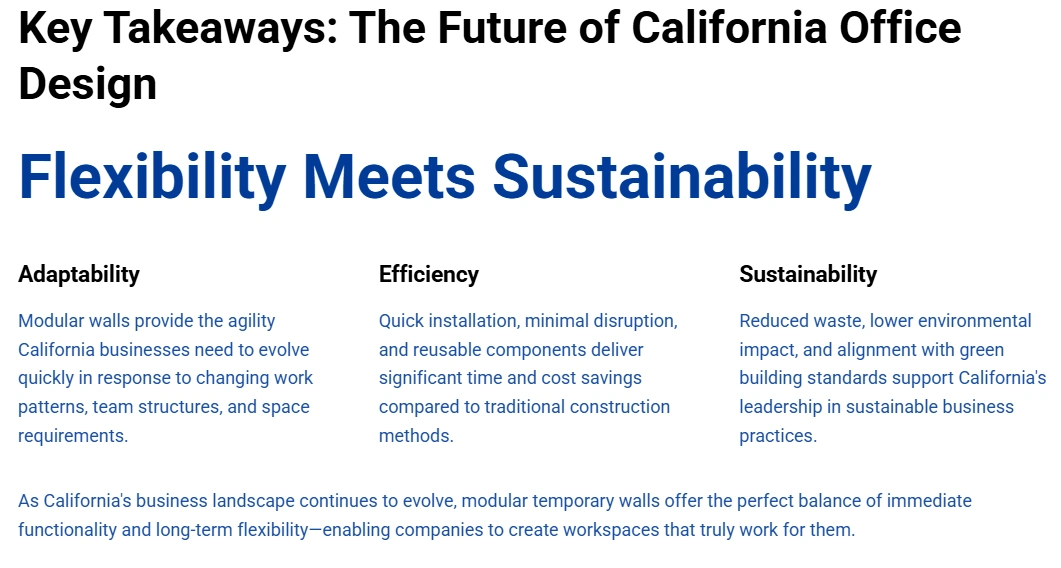
Finding the Right Fit
Choosing between renting or buying often comes down to timeline, square footage, and future planning. Many clients begin with a rental and convert to ownershiponce needs become more permanent. A modular wall partner like 5DCCScan help you model cost scenarios and forecast ROI for either approach.

